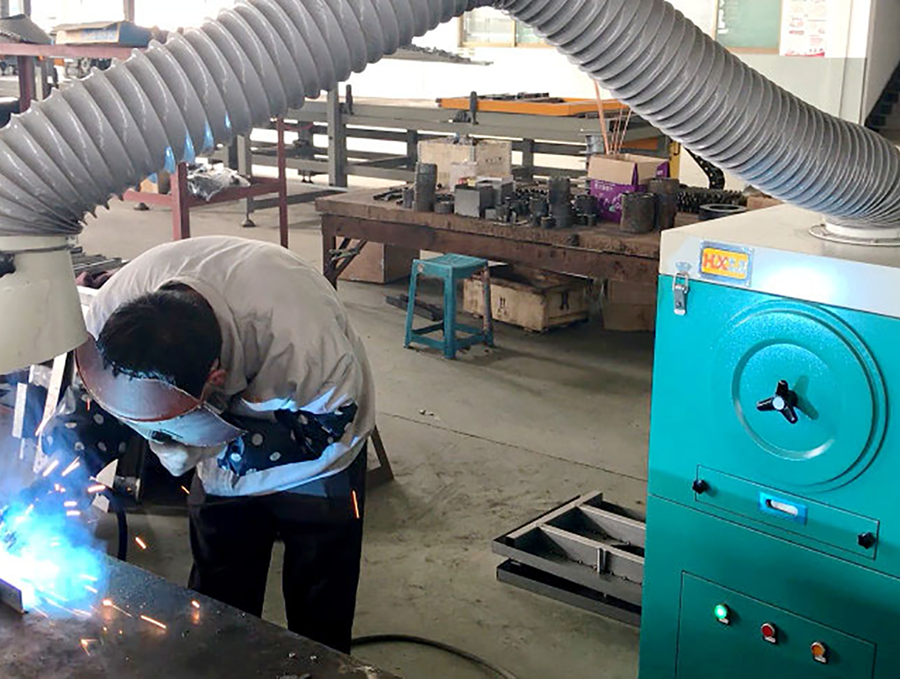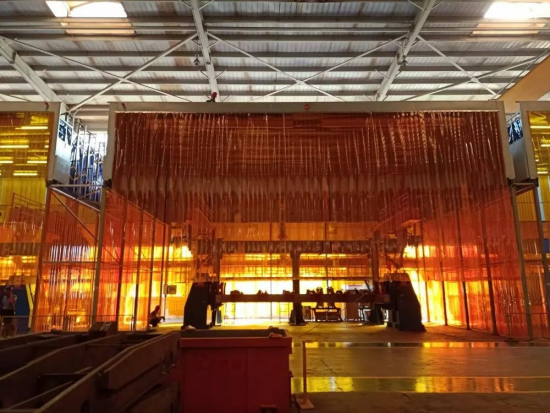A Welding Workshop Dust Removal Method Balancing Ventilation and Dust Removal
Harmfulness of Welding Fumes
During welding operations in welding workshops, a large amount of dust and pollutants are generated, characterized by: ① Small particle size, with dust particles being fragmented and having a diameter of about 1mm. ② High viscosity of welding fumes. ③ High temperature of welding fumes. ④ Large amount of dust generated during welding processes. Generally, a welder produces 60-150g of dust per day. Due to the extremely small diameter of welding fume particles, nose hair and nasal mucosa cannot effectively block them, posing health hazards to workers.
Traditional methods for handling welding fumes typically involve collecting them at the front end and purifying them with rear-end dust collectors. However, this method affects workshop space and generally occupies space above the factory building. Is there a way that does not occupy factory space? Yes, there is!
Ventilation and Dust Removal
Blow-suction Circulating Welding Fume Purification
To reduce pollution in welding workshops, welding fumes can be treated through ventilation or dust removal methods.
Ventilation ensures good circulation of air between the workshop and the outside environment. By promoting airflow, welding fumes are quickly dispersed, reducing the amount of fumes lingering in the workshop, thereby purifying the workshop air and reducing the harm of fumes to workers' health.
The difference between dust removal and ventilation lies in the addition of collecting and centralized processing of welding fumes. Dust removal mainly falls into two categories: one is to install suction heads at welding points or where welding fumes are generated, to suck them into pipelines before they spread widely, and then transport them to the outside of the workshop or for centralized treatment through pipelines.
Is there a way to combine these two methods?
Yes, there is!
Huaxin YT blow-suction dust removal integrated machine can achieve it.
Principle of Blow-suction Circulating Purification
Arrange dust collectors along both sides of the workshop, install blow-suction dust removal pipelines on the dust collectors. When the equipment is in use, the suction port sucks in welding fumes for purification, while the blow port blows out clean air, accelerating the circulation of workshop air, thereby accelerating the purification of the dust removal system.
Blow-suction circulating purification is used to treat the overall workshop welding area. In the production process of on-site welding production lines, a large amount of harmful welding fumes is generated, including toxic metal oxides such as iron oxide, manganese oxide, and fluoride. These metallic fumes can cause certain harm to the human respiratory system, skin, eyes, blood, etc. To protect workers, welding fumes and grinding dust need to be purified and treated.
The YT dust collector has 6-8 groups of nanofiber dust removal filter cartridges internally.
Applications of Blow-suction Circulating Purification
Blow-suction circulating purification is not directly targeted at the smoke-generating area, so the dust removal system is not affected by the size of the welding workpiece or changes in welding positions.
01. Blow-suction circulating purification is not limited by the size of the workpiece. The dust collectors are arranged along both sides of the workshop. Welding fumes are sucked in and clean air is blown out through blow-suction dust removal pipelines, without traditional front-end collection devices, thus not affected by the size of the workpiece.
02. Blow-suction circulating purification does not affect crane lifting. The dust removal system pipes can be selected to be higher or lower than the crane height as needed, unaffected by crane lifting.
03. Blow-suction circulating purification achieves thorough smoke and dust removal. The dust collector uses membrane dust removal filter cartridges to treat smoke pollution, with a particle filtration accuracy of 0.3 microns and a dust removal efficiency of 99.9%, meeting environmental assessment standards.
For large workshops with multiple workstations, complex operating conditions, and requiring crane lifting, if traditional front-end dust removal devices are not desired to be installed to achieve welding fume purification, then a better choice would be blow-suction circulating welding fume dust removal equipment. Its collection is not directly targeted at the smoke-generating area, so the dust removal system is not affected by the size of the welding workpiece or changes in welding positions, solving the dust pollution problem for many enterprises and contributing to improving work efficiency!

![[Dust Removal Case] Plate Welding Dust Removal Solution for a State-owned Coal Mine Machinery Comp](/d/file/p/2024/10-28/fa90a7026c233450e7f014c8eb9d79c5.png)
